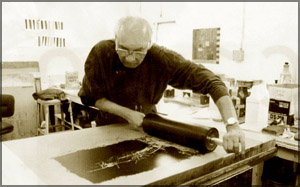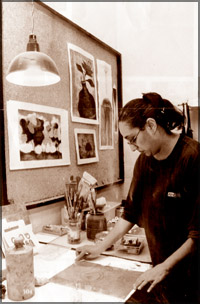|
Original Impressions
Husband-wife team saves little-known art form
by Rohan L. Jayetilleke
The Shahpur Jat is a
narrow lane in New Delhi. Ensconced in this narrow lane is 'Atelier
2221', a studio offering world-class print making facilities, fighting
for survival though.
The owner of this studio, Pratibha Dakoji says, "Print is an original
form of art and she repeat it again a again. Her impatience is quiet
disturbing to an art critic, as there is a lack of knowledge about this
art medium in India there is no impact on art its market severely.
Pratibha explaining the difference between prints or copies of a work
of art and print-making, she says, "In case of a painting, artist uses
paints, brush and a canvas. Copies of such paintings are not called
'original art'. In print-making however, the artist makes his own
drawings on a matrix plate instead of on paper. This plate is worked on a medium of the artist's choice and is then developed into as
many editions as the artist wishes. Each of the print is signed by the
artist, which proves of its originality".
worked on a medium of the artist's choice and is then developed into as
many editions as the artist wishes. Each of the print is signed by the
artist, which proves of its originality".
Pratibha, who grew up in East Africa and studied print-making at the
Chelsea School of Art in London, further explains that after the artist
has drawn on the plate, he is assisted by a master printer,
professionally trained to deal with the medium.
That is why, she says, it is also called collaborative art.
Pratibha's husband, Devraj, a master printer with several years of
expertise in premier institutions like the Tamarind Institute in New
Mexico and Bob Blackburn's Print-making workshop in New York, says,;
"Somehow even the best known artists in India are hesitant to pursue
print-making. They are on tender hooks because of the lack of awareness
of collectors in India. Thus, this medium needs more promotion for a
wider and lucrative market.
In contrast print-making is a very popular medium in the West.
Britain, for example, has 70 edition studies and there are over 100 such
studies in and around Paris. Van Gogh and Picasso have been involved
with prints.
 In
India, Raja Ravi Verma, had set up a workshop in Lonavala in 1894 with a
German painter and a technician, who by the dot technique, copied the
paintings which was then varnished to give an effect of an oil painting.
These and similar works are called oleographs. In
India, Raja Ravi Verma, had set up a workshop in Lonavala in 1894 with a
German painter and a technician, who by the dot technique, copied the
paintings which was then varnished to give an effect of an oil painting.
These and similar works are called oleographs.
"Ours is now the only commercially functioning edition studio in
India" the husband and wife duo of Dakoji say, "Though Central
government's autonomous model organisation of Lalita Kala Kendra do have
the facility, they do not provide the expertise and as such the artists
have to do everything themselves.
This becomes a nerve-wrecking experience to the artist. Besides, more
artists would not know the technique of taking out print editions in the
first place".
In the discipline of print making affordability is the most
adventurous. An artist could price an original print at much lower price
than an original canvas painting. In case an artist can make Rs. (Indian
- Sri Lanka rupees is nearly 67 per cent below par to the Indian rupee
and still continuing to tumble) 5,000 per print, he could safely make Rs.
5 lakhs for 100 prints.
The same creation on a canvas is more time consuming and never
cost-effective, costing much more than Rs. 5,000 per canvas, it takes
longer days and hours of concentration, where human error is not
tolerated at any cost.
Therefore, printing makes original art more budget-friendly and
affordable for the middle and upper middle class market, who form the
segment of art connoisseurs in India, a trend totally absent in Sri
Lanka even among the richest of the rich or even corporate business
houses, banks, who spend lakhs and lakhs of rupees for audio-video-print
and cutout advertising of their goods and services, and the walls of
their office mansions are just blank giving the impression - writing is
on the wall - we do not promote painters.
In India there is an awareness and appreciation among the middle
class about art, for they know, India has a long heritage in art dating
back to 5,000 B.C., as yielded by the clay seals yielded by the
excavations of Mohendojaro and Harappa cities (both now in Pakistan
territory) where engravings of animals are there.
Further, this Indus civilization's script which has still not been
deciphered is pictographic, with around 400 scripts, meaning pictures of animals. The modern scripts of all
languages are based on the parts of the bodies of animals.
scripts, meaning pictures of animals. The modern scripts of all
languages are based on the parts of the bodies of animals.
This middle class art lovers could afford Rs. 1,000 to Rs. 5,000 for
an original print, which is within their earnings. Thus print-making has
ushered in an untapped market for the artists. For a print, unlike a
painting does not get mellowed or fade away or get destroyed with the
march of time.
Presently, this writer's experience in New Delhi, there is a shortage
of good master printers. Anyone who knows print can pull print editions
out but only a master printer who could give it that professional finish
can make it an art form. Atelier 2221 has hosted artists like B. C.
Sanyal and Manu Parekh and also promotes promising upcoming artists.
If you are a painter, why not just fly to Chennai, take TK electric
Express Train to New Delhi 47 hours travel and drop in at Atelier and
gather the discipline and start print-making in Sri Lanka. |
